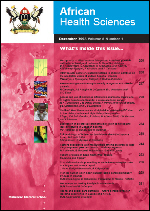
|
African Health Sciences
Makerere University Medical School
ISSN: 1680-6905
EISSN: 1680-6905
Vol. 20, No. 2, 2020, pp. 579-586
|
 Bioline Code: hs20021
Bioline Code: hs20021
Full paper language: English
Document type: Study
Document available free of charge
|
|
|
African Health Sciences, Vol. 20, No. 2, 2020, pp. 579-586
| en |
Prevalence of hepatitis B and C virus co-infection in HIV positive patients attending a health institution in southeast Nigeria
Nnakenyi, Ifeyinwa Dorothy; Uchechukwu, Chisom & Nto-ezimah, Uloaku
Abstract
Background: The health of people living with HIV/AIDS becomes progressively worse when co-infected with hepatitis
B virus (HBV) and hepatitis C virus (HCV), resulting in shortened life span. The modes of transmission of HIV, HBV and
HCV are similar.
Objective: To determine the prevalence of HBV and HCV co-infection in HIV patients.
Method: This was a retrospective study of serology test results for hepatitis B surface antigen (HBsAg) and antibodies to
HCV (anti-HCV) of HIV positive patients registered from 2008-2013 (6years) at the University of Nigeria Teaching Hospital. Adult patients with confirmed HIV seropositivity were included. Ethical approval was obtained and confidentiality of the
patient information was maintained. Laboratory records were reviewed to obtain HBsAg, anti-HCV, and CD4 T-lymphocyte
results. Prevalence was determined by the number of positive results over total number of patients tested. Chi-square test
was used to determine relationships and p<0.05 was considered to be statistically significant.
Results: 4663 HIV patient records were included comprising 3024 (65%) females and 1639 (35%) males. Serology results
showed 365/4663 (7.8%) tested HBsAg-positive only; 219/4663 (4.7%) tested anti-HCV-positive only; and 27/4663 (0.58%)
tested both HBsAg and anti-HCV-positive. Correlation of age and sex were statistically significant with HBV and HCV
(p<0.05) but not CD4 count (p>0.05).
Conclusion: HBV co-infection was more prevalent than HCV, and triple infection was also observed. Screening for these
viral infections in the HIV population is necessary for early identification to enable appropriate, holistic management of
these patients.
Keywords
Hepatitis B virus; Hepatitis C virus; HIV; co-infection.
|
| |
© Copyright 2020 - Nnakenyi ID et al.
|
|
